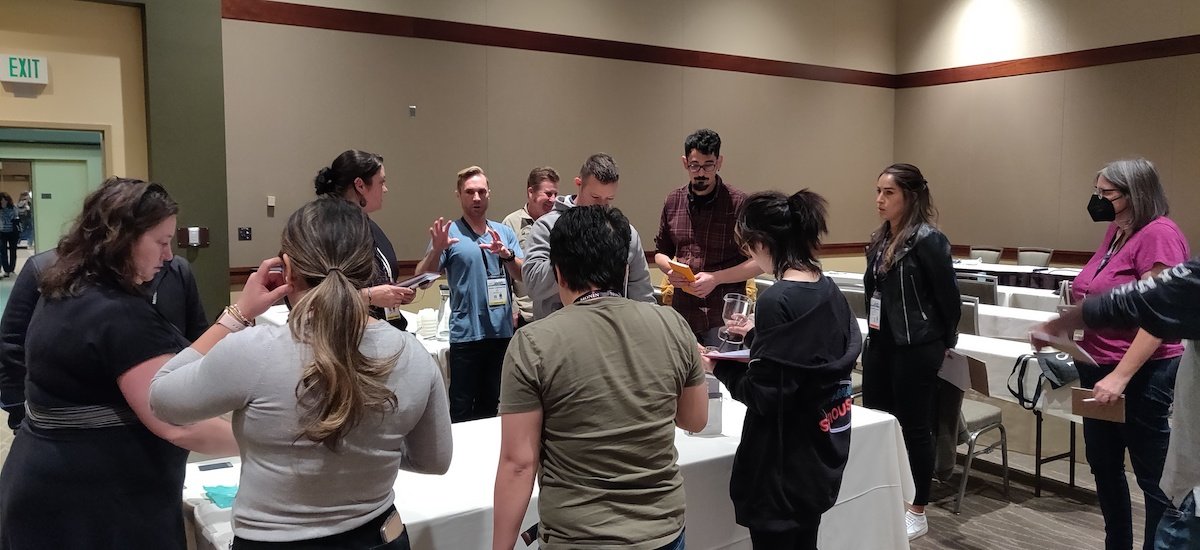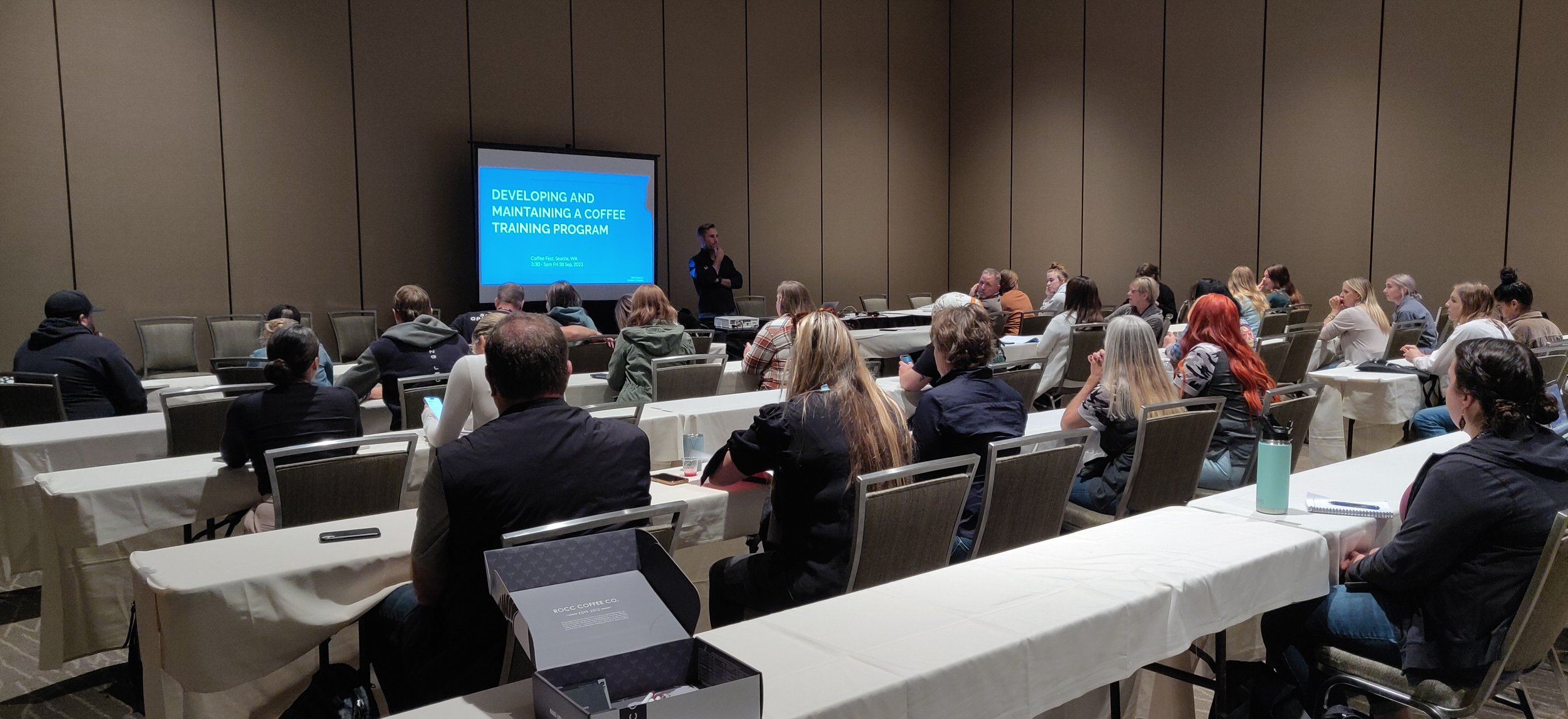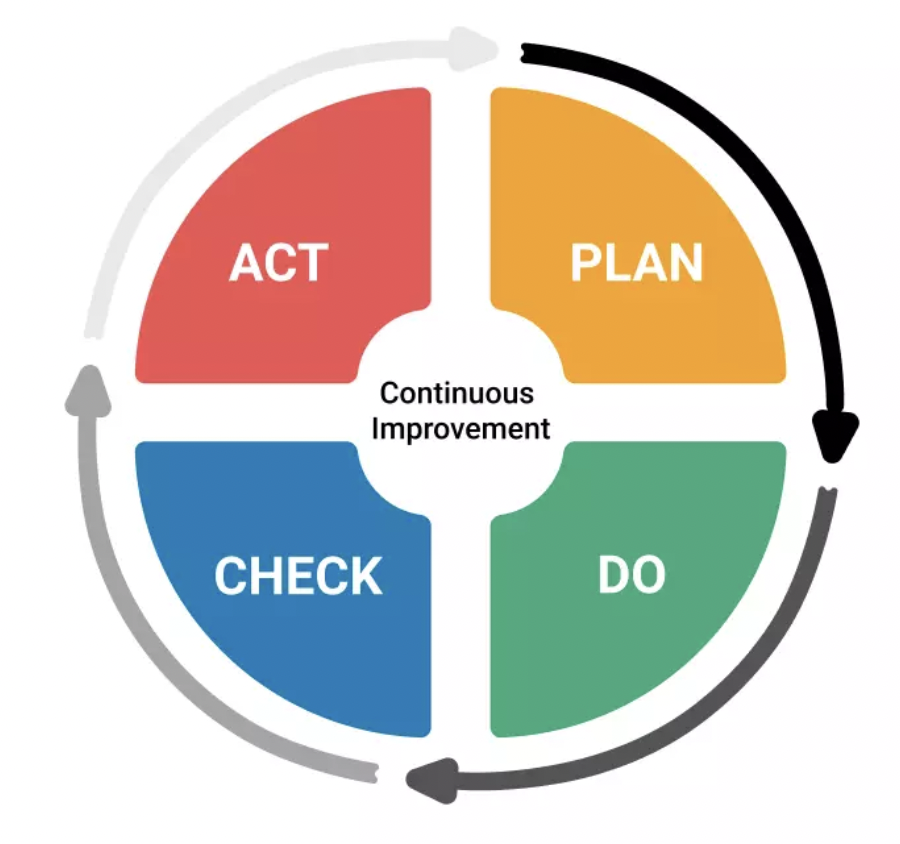Presented at Coffee Fest, Seattle, WA
Friday 30 Sep, 2022
By Adam S. Carpenter
Founder & Lead AST
ROCC Coffee Co.
Thank you for attending this session!
How to Get the Best from Your Beans.
I’m excited to work on this topic together with you today. I intentionally use that phrase, “work on this topic” because we are all learning and growing to develop better coffee training programs and methods to maintain them well. Thank you.
This is one of three sessions prepared for Coffee Fest PNW, 2022.
Developing and Maintaining a Coffee Training Program.
How to Get the Best from Your Beans: from Sample, to Profile to Production Roasting.
Cupping Controversial Coffees.
If you are interested in these other sessions or would like to connect, I would be happy to share and dialogue.
This session has an accompanying PDF available by blog and email. There may also be discount codes available if you wish to join one of our certified Specialty Coffee Association courses always available online.
We also have great training kits available at www.sca.training with tools and equipment at www.rocc.coffee.
Introduction and a Caveat
Every speaker has the desire to be well received and feels a desire to “impress the crowd”... so I really want to lay that aside and approach our time with humility.
This talk is an attempt to put to words my regular work in coffee roasting since 2012 while applying a more concrete approach that I created in 2019.
The regular work was roasting for ROCC in Central China where we had to take low cost and often poorly transported coffees and do our best to roast them in such a way that “every bean would shine”.
The concrete example we will explore together moves us from sample to profile and production with a Monte Cristo Guatemalan coffee aged in a single malt, Oregon rye whiskey barrel.
I realize that this is by no means a “cookie cutter” approach to coffee roasting, but it shall be our springboard for dialogue and tasting today.
My name is Adam and I love helping people and businesses grow. Our vision at ROCC is to use training and tools to build a Global Community and Provide a Playground that Makes Life Better.
I grew up on a small farm in Michigan drinking Folgers instant coffee with my dad and grandpa. They worked hard and I wanted to be like them. In university I had the chance to stay at a Costa Rican coffee farm. Picking coffee cherries by day and playing futbol at night changed my life. My wife and I married, went to China as English teachers and then in 2012, I opened Central China’s first artisan coffee roastery - ROCC. We roasted wholesale coffees and had two retail outlets. One coffee window and one full Coffee Discovery Bar. In 2015 I started training as a fully certified AST with the SCAE running courses in both English and Mandarin Chinese all over China. Today I lead certified SCA courses online and offline in the Coffee Skills Program while supplying training tools and coaching for clients - especially roasters & labs.
I would be honored to work with you or your team to grow your business.
How to Get the Best from Your Beans
Today we are working with a Colombia Excelso EP. EP stands for European Preparation which is sorted to ensure the screen size is above 15. Let’s assume that I have already looked at a few different Colombian samples with standard green grading and SCA cupping protocols… this is step 2. How to make this bean shine inside my roastery, blends and coffee offerings.
This Colombian Excelso EP is the kind of coffee that I might have multiple uses for. Perhaps it could be used as both a single origin and as a really solid blender. I may want to omni-roast it for various extraction methods. To understand this coffee better I would roast and prepare 5-6 different cup profiles.
You may wish to use this coffee in more than one brew application.
If you want to go about roasting at various levels for multiple uses, then the roast levels exploit a range of incremental changes. My goals was about 5 degrees Centigrade (that’s 9°F) for a pretty broad survey. I will hold charge temp, roast method, etc. all in control with the only variable of change being target drop temperature. As a result of higher drop temperatures the total roast time and other secondary variables will naturally move.
I roasted these coffees, which are on the table today, from a very light middle of first crack dropped at 200°C all the way up to a middle of 2nd crack dropped at 224°C.
Roasted to drop temperature: 200° - 206° - 209° - 215° - 220° - 224° Centigrade
This provides me a very full range of possibilities inside this bean. It may help me see what is possible for filter brewing and even espresso use. Lets taste and comment on these roasts to see what this bean is capable of.
Here we proceeded to cup the 6 coffees as they were laid out in sequential roast order on the tables.
Cupping Feedback
Here we cannot replicate the cupping which occurred at Coffee Fest, but I’ll summarize and describe what happened. General feedback follows from each of our 6 roast levels:
ROAST LEVEL:
Fast Light 200°C Very bright, high acid, juicy, unbalanced like lemon
Sample Level 206°C Clean bright lemon acidity, high sweetness, full body
Med-Light 209°C Caramel, nuts, sugarcane, balanced acid and body
Medium 215°C Cinnamon, spices, dark chocolate, bitterness and body rising
Start of 2nd 220°C Roasty with wood and cacao notes, dry bitter finish
Mid2nd Crack 224°C Roasty with wood and cacao notes, dry bitter finish
Warning!
You can only use my drop temperatures and profiles as a guide.
Every roaster and bean probe will behave differently. Explore and define yours.
As you can see this coffee has a wide range of qualities and potential use cases. Many clients and roasters seek dark, “bold” and rich flavor profiles like we experienced from 215° - 224° C. drop temperatures. The heavy body and chocolate spices would lend to a very good espresso blend or dark roast blend.
In my personal experience and preference I blend my dark or French roasts to ensure that there is no one defining characteristic. Very few coffees stand alone and age well in the bag as dark roast single origins. I might consider blending this dark Colombian with some other nice dark roasts like Peru, Mexico, Kenya, Sumatra or India.
Considering the light roasts between 200°-209° C. drop temperatures I was very surprised how high the acidity and sweetness levels were. I was very pleased with the Sample Roast level at 206°. I call this “sample roast” because it had just completed its first crack and would typically fit that SCA cupping protocol of 63 ground Agtron Gourmet color.
The 200° C. was too light with some grassy and astringent notes. The 209° C. was in fact really nice, but just was not what I needed for my clients and portfolio presently. The hopeful note I have in each range displaying quality is that as this coffee ages 3-6-9 months in storage I know that various roast levels or qualities may be displayed.
Your coffee is alive and will change with age.
Roast Profiling and Scaling for Production
These coffees were roasted on a small drum convection air roaster made by ROEST. The sample sizes were only 100 gram batches and the roasting is both efficient and fast. How then shall we consider scaling up our ideal profiles for a traditional large production roaster. For our example, lets consider a 12kg / 25lb gas powered drum roaster.
Scaling a roast from 100g to 10kg.
Transferring profiles from convective air roaster to a gas drum roaster.
We should ask, what variables can we hold on to and which ones should act as targets or controls? By identifying our targets and controls we can allow the others to move and adapt as they would naturally with scale. The root of our logic is that this is physics, math, thermodynamics at work (scaling) while we seek to preserve and replicate the chemical and sensory properties of the roast.
We use the cupping table and sensory observations as our target outcomes.
We hold drop temperature and general development as our leading indicators.
Time for Math!
Let’s look at a few different roast profiles and examine how we might scale, stretch and adapt them to move from a 100g sample air convection on ROEST to a 10-20kg roast on a traditional gas drum.
This was the daily work and regular mental math we would employ on our old Diedrich IR-12 while roasting in Central China. Our samples were prepared on a Quest M3 (300g) electric drum roasters while the Diedrich IR-12 burned propane LPG from tanks.
We kept paper records and recorded simple T-Charts to watch Rate of Rise (ROR) as it moved. Mentally calculating and predicting ROR is a very important skill for roasters to feel, predict and guide their roasts.
Today roasting software performs this work and multiple calculations for us. We get real time ROR feedback with colors and percentages to guide our drying, development and roast percentages.
We will reverse engineer those percentages so that we can understand how we want to scale or stretch from our sample roast up to a production roast plan - with the goal of preserving cup qualities and attributes.
Roast #1 - The Super Light 200° Drop
Let’s use roast #1 as a control and example. If we can reproduce this roast on a production roaster, the others should easily follow. The challenge we face on lighter roasts is that our small convective sample roaster is capable of fast and efficient roasting. When we move from 100g to 10kg we have multiplied the bean mass 100 times!
FROM ROEST SCREENSHOT - LINES REPRESENT:
Blue Air Environmental Temperature °C (ET)
Red Bean Probe Temperature °C (BT)
Light GreenRate of Rise °C / Minute (RoR)
Dark Green Fan Speed as %
Purple Drum Chamber Speed as %
Black Power (Heat) Setting as %
I held charge temperature consistent at 165°C (ET) on all roasts for the x6 profiles. Fan speed followed the same path for each while drum speed never changed at 55%. Power was changed slightly on each to accommodate for end of roast variances - indicated by “manual” control markers.
Remember that RoR and probes are tools.
Sensory perception and the cupping table are the rules.
Opening the cafe went poorly, “it’s my fault for not ensuring we had the supplies ordered last week.” But you may say, “it’s my manager's fault for not ordering.” Then we come back to ask, “why is it my fault that the manager did not order last week?” Admit, “it’s my fault that I didn’t provide training or checklists or time or accountability or a clear system and process for my manager to ensure that they ordered last week.”
Let’s look more closely at Roast #1
Specifically let’s answer the question how should we plan for this 6:25 roast to move up to a full production roast? How could we plan for a 9 minute roast on the production roaster? What should change? First, what do we know about the 100g roast? And importantly, let’s configure all times into seconds.
For example take 6minutes 25 seconds and convert: 6 * 60 = 360 + 25 = 385 seconds.
Turning Point was at 30 seconds
Dryend was at 150° at 2:45 which is 2 * 60 = 120 + 45 = 165sec.
First crack at 200° was at 5:40 = 340sec.
End at 200° at 6:25 = 385sec.
Use division to find a percentage of time from dryend 150° to end of roast 200° using time.
385s - 165s = 220s (or 3min40sec) and 220s / 385s = 57%
57% of our roast time was spent climbing from 150° to 200° or just over half the roast time.
We could predict that more than half of a 9 minute production roast will be used for 50°
What is 57% of a 9 minute roast?
9min = 540 seconds * 57% = 308 sec or 5min8sec spent from dryend to end.
We also know that 100% - 57% = 43% the amount of time spent from charge to dryend.
43% of 9 min = 540 sec * 0.43 = 232 seconds
Using these basic calculations and logic, we can start to establish a plan to approach our production roaster. For example, you may know that large roaster needs a higher charge temperature if we are going to reach 150° C in 3 minutes and 52 seconds.
An important perspective (if this calculation works for us) is to view the relationship between our 2 roasters at the 57% up-scale. For simplicity we might say as a rule that 1.5x works. But we have not tested everything yet.
Perhaps you will find a general 1.5x scale relationship between your roasters.
Roast #2 - SCA Sample Level 206° Drop
Here is our second sample which was an SCA Sample roast level. We might also call it our target for a really nice bright single origin roast. We’ll use our same scenario of a 12kg production roaster from our 100g sample roast. To roast a little longer and darker we estimate that 10 minutes on our large roaster will be required.
Question: how much time and what percentage of the roast should be spent from the start of 1st crack to the end of the roast (drop time) at the 206° target?
QUICK NOTES FROM THIS ROAST:
Total roast time was 6 minutes 34 seconds. That converts to: 6 * 60 = 360 + 34 = 394 seconds.
Turning Point is 30 seconds.
First crack 200° at 5:20 = 320 seconds.
End first crack and roast at 206° in 6:34 = 394 seconds.
Development calculation is 394 - 320 = 74 seconds.
Development percentage is 74 / 394 = 19%
19% of our roast was spent from first crack to the end.
Our production roast should take 10 minutes * 60 sec = 600 seconds.
19% of 600 sec = 600 * 0.19 = 114 seconds or in minutes that is 1:54
The theory at work is scaling up and down. For the sake of simplicity I am assuming that we know (or can predict) that the small sample ROEST works 1.5 times faster than the large roaster. So estimating our 10 minute end of roast should be tested and confirmed on the cupping table.
Example #3 - The Whiskey Barrel Project
You may read in great detail about my process and approach at the ROEST Coffee blog at the link included here: https://www.roestcoffee.com/roestblog/barrel-aged-coffee-roasting or by searching “ROEST barrel aged roasting.”
Our goal was to preserve the sweet banana spiced attributes of our Guatemalan Whiskey Barrel Aged Coffee.
At the time of this project I was working at a roastery with 2 San Franciscan SF25 roasters. I knew if I was going to achieve a fast roast that I could only roast at about 50% capacity. So we scaled my 120g sample roast to a 12lb green mass on the SF25.
I used the roast development weight loss as a target. On my sample roast I had a 14% weight loss from 120g green to 103g. Besides the cupping and sensory characteristics we were hoping to see the 12lbs green have a target weight of 10.32lbs after roast. If this variable remained constant with our profile scaling we expected that a similar chemical process was happening to the beans.
Roasting on a SF-25 required the 5:55 sample roast profile be stretched about 1.5x times. In order to achieve this with a long deliberate soak in the beginning, we had to race up to first crack before ending our production roast at 9minutes 30seconds with a target of 410°F (210°C) to finish.
We were able to do so with only 50% drum capacity. With 14% moisture loss and cupping results in - we had found a winner!
Closing Thoughts, Questions & Answers
In this presentation, I have shared many things which could appear to be “rules.” However, I want to be clear that I am showing you the logic and procedures that I have found over the past 10 years to guide me in scaling, profiling and producing roasts on multiple roasters at many sizes.
I have used these methods on 50-300g sample roasts in convection air roasters, drum electric and drum gas sample roasters. I have scaled to 2kg profiles on electric drums at 120v and 240 voltage. I have profiled and scaled to 10kg Diedrich infrared porcelain burners on propane and equally with 20lbs on a gas SF25 drum. Like a rubber band that stretches to accommodate each situation - the logic and science hold out to the cupping table.
It’s question and answer time. I’d love to hear your thoughts, curiosities and struggles. We can dialogue in the chat here or elsewhere when you find this online.
Thank you for your time on this topic!
I have other presentations available at the www.sca.training blog.
Tools and equipment can also be found at the www.rocc.coffee lab.
If you would like to connect on this topic or with Specialty Coffee Training programs please reach out. My email list provides coupons and course information with link: http://eepurl.com/cZU5R1
Instagram @HowToCoffeePro


















